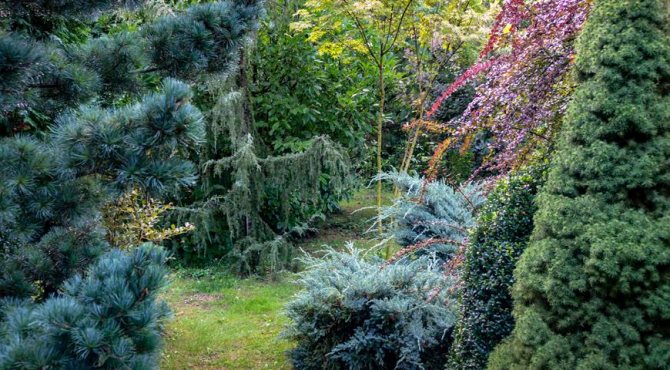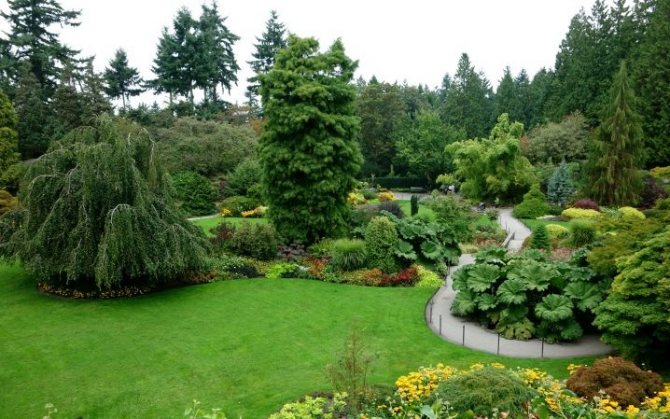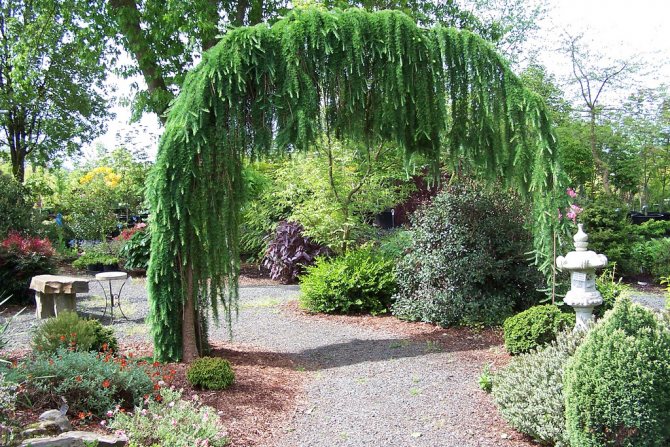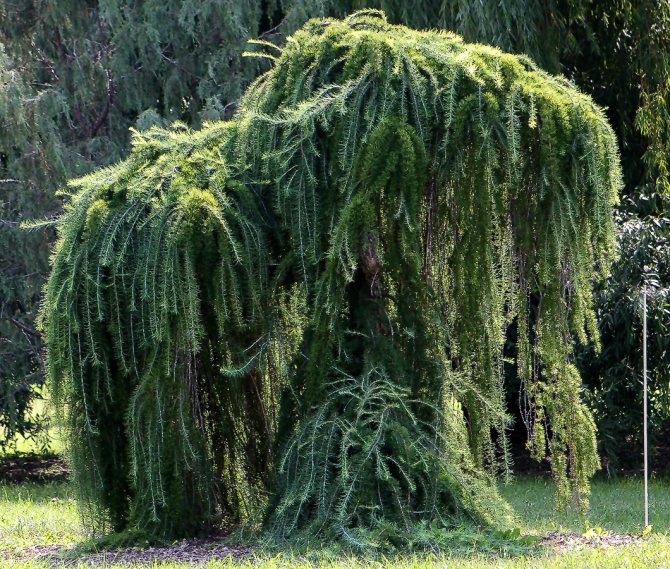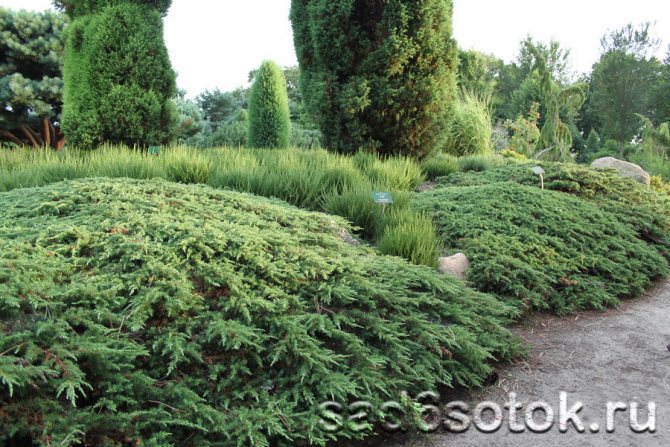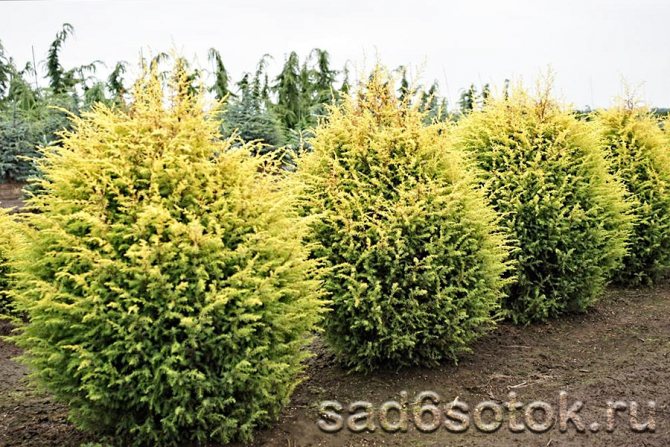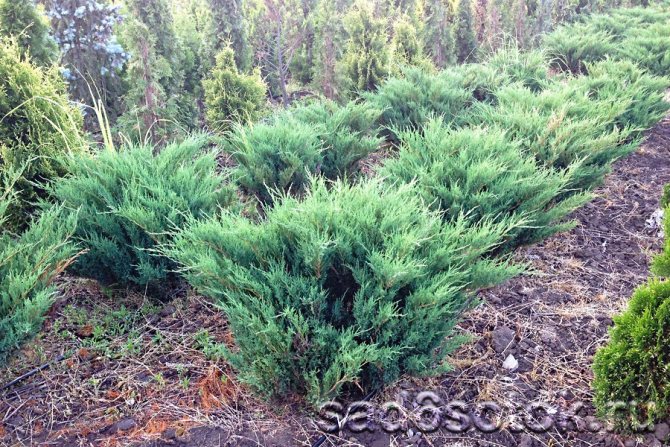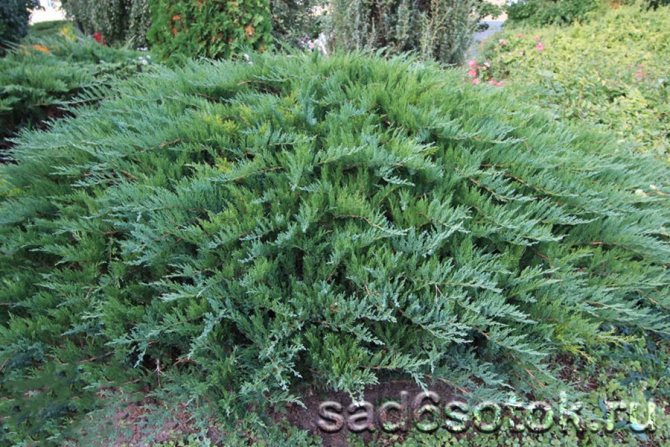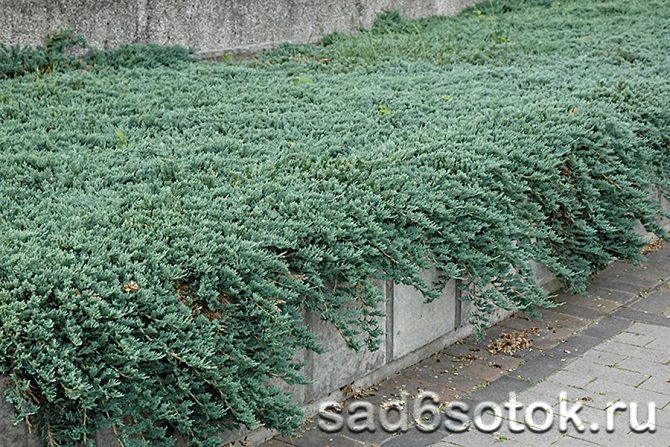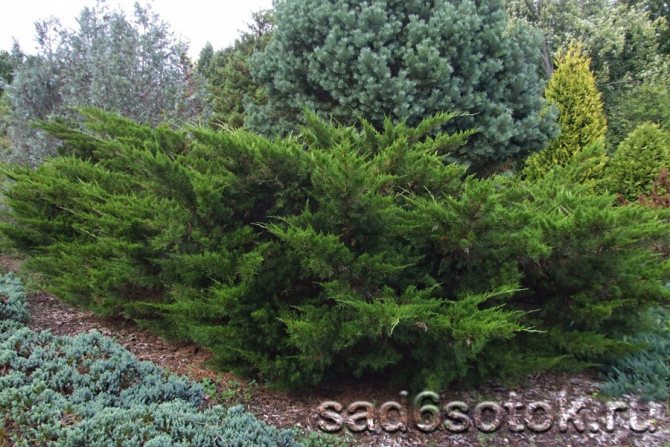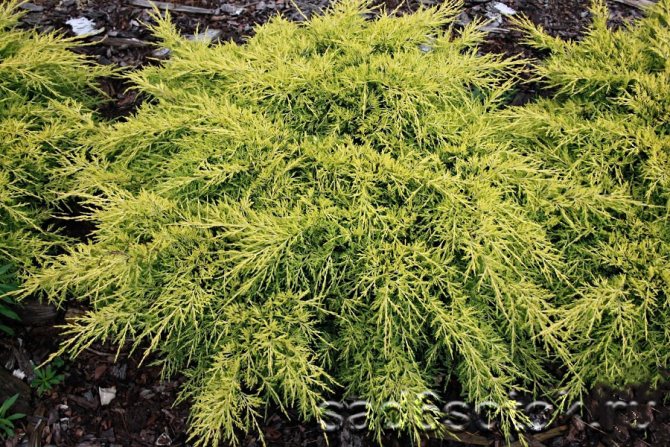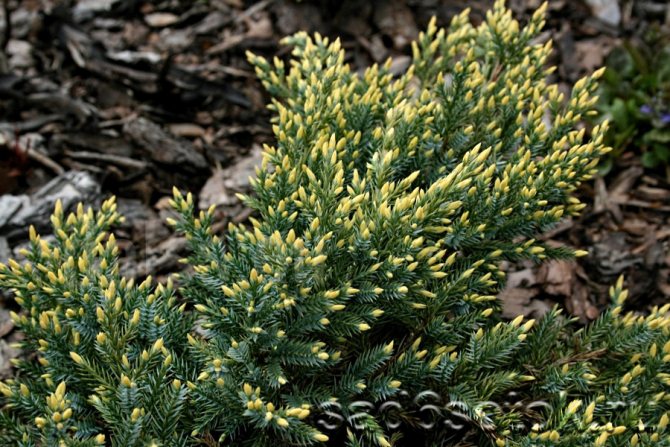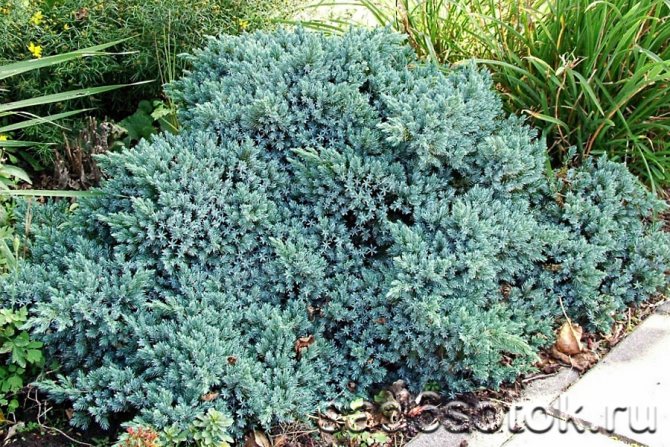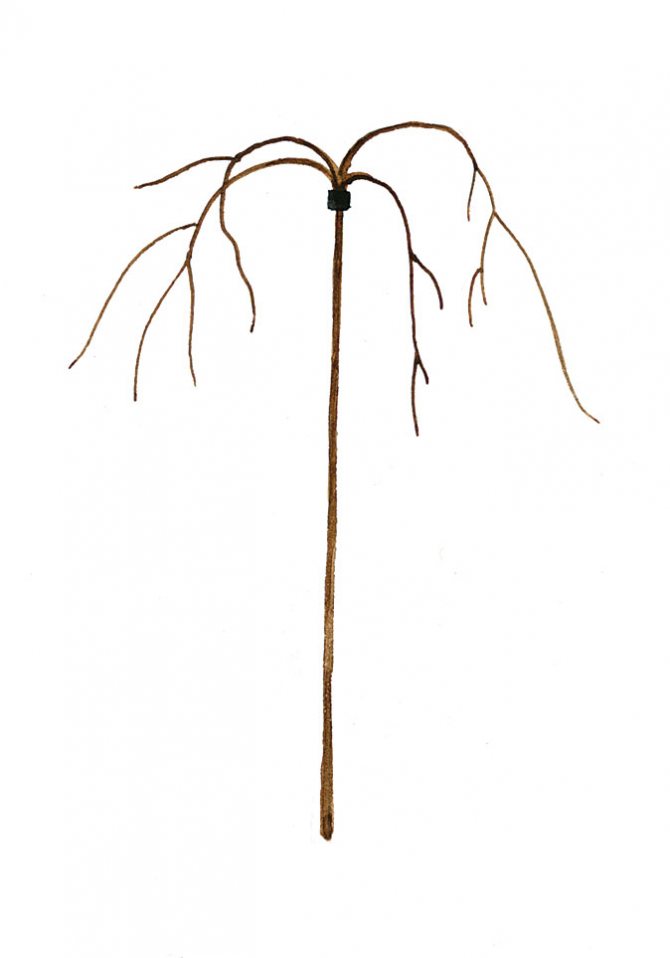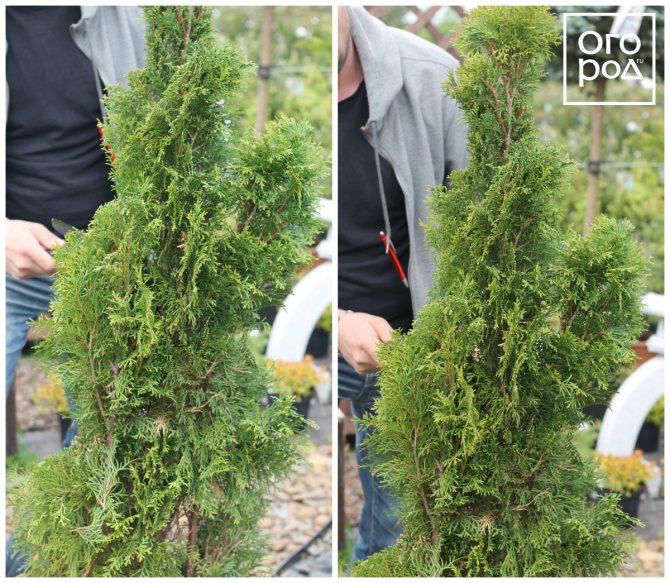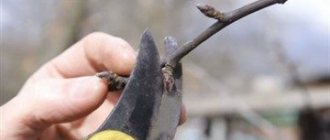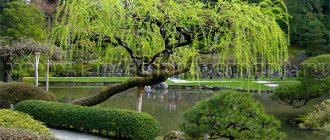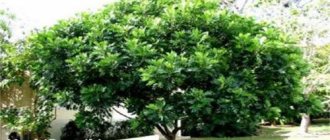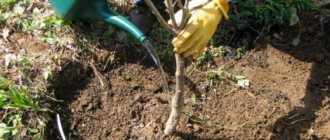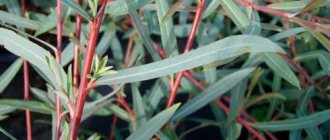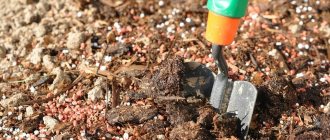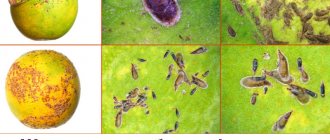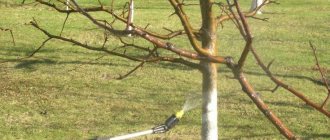Recently, standard trees planted in symmetrical compositions or in a zigzag pattern are gaining popularity in landscape design more and more.
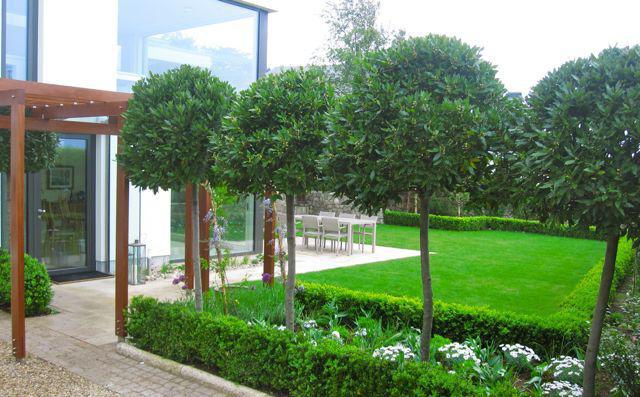
What is the essence of a plant of this form? How to make a standard tree with your own hands? What are the planting materials to use? What are the secrets for their cultivation and care? Let's find out.
Description of the species
A stem tree is a plant with a long trunk, the top of which is decorated with a fluffy spherical crown or foliage falling down. Such plantings look original and impressive.
Standard trees differ in size and height. Usually their length varies from one hundred and fifty to two hundred and fifty centimeters.
In addition to an attractive aesthetic appearance, they have other advantages and benefits:
- save space;
- facilitate harvesting;
- contribute to comfortable service.
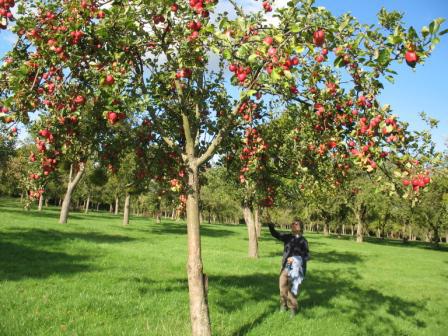

Basic forms
How to grow a standard tree on your personal plot? This is not difficult to do. The main thing is to decide on the choice of form.
By the appearance of the crown, standard plants are divided into:
Weeping trees include willow, mountain ash, elm, some types of apple trees, as well as creeping shrubs: climbing rose, juniper, cotoneaster.
In most cases, these plants are artificially grafted so that their branches fall down. This can occur vertically, in an arc, at an acute angle, or umbrella-like.
Spherical shapes include maples, acacia, larch, thuja and others.
There are several ways how to form a standard tree - by grafting and by pruning. Let's talk about these two methods in more detail.
In the meantime, let's find out the general rules for planting a suitable seedling.
Bright originality
With the help of juniper bushes, you can make a wide variety of shapes on your personal plot.
Japanese larch is very popular. The fall of leaves inherent in coniferous needles does not diminish its popularity. Smooth horizontal branches and multi-vertex trunk of the larch make it easy to shape it into a ball. Despite the prerequisite for maintaining a distance of 3-4 m from the larch stem, the opportunity to decorate the site with bright tints of flowers with other stems is not missed by any professional designer.
Before planting
Above, we determined which specific plant species are best suited for standard trees and shrubs. Now let's find out how to choose the right seedling.
First and foremost, the trunk of the plant should be straight and even. Remember: if knots and bends are found on the planting material, then in the process of growth they will not go anywhere, which means that the tree will lose its originality and attractiveness.
Moreover, when choosing seedlings, you need to pay attention to the healthy appearance of the bark and root system.
And one more thing - immediately after planting, a young tree needs support. Fix its trunk along with a wooden peg placed next to it.
Weeping trees for the garden
More than a century ago, weeping plants became popular in European and Eastern gardens.Sometimes the weeping crown shape is created by nature, and sometimes it is made like this by cutting or artificial formation in nurseries.
Shrub or weeping willow
Flowering trees and ornamental shrubs for the garden
More than 600 species of willow are known, among which there are tree-like forms and shrubs. All have narrow long leaves, transparent flexible crown. The willow branches are thin and slightly pointed. Most representatives do not grow taller than 15 m, but there are also giants up to 40 m.
Willow trees and shrubs
The question often arises whether the willow is a shrub or a tree. The dispute about whether the willow is a shrub or a tree, biologists believe resolved in favor of the version that both forms take place. In the north of Russia, the bush willow is widespread, successfully resisting harsh winters. Exceptional unpretentiousness to soil allows it to grow everywhere.
Note! More than 300 varieties of weeping willow are known. Its shoots fall down in beautiful waves that look very advantageous next to any body of water. Dwarf varieties are successfully used for the design of rock gardens, the formation of hedges.
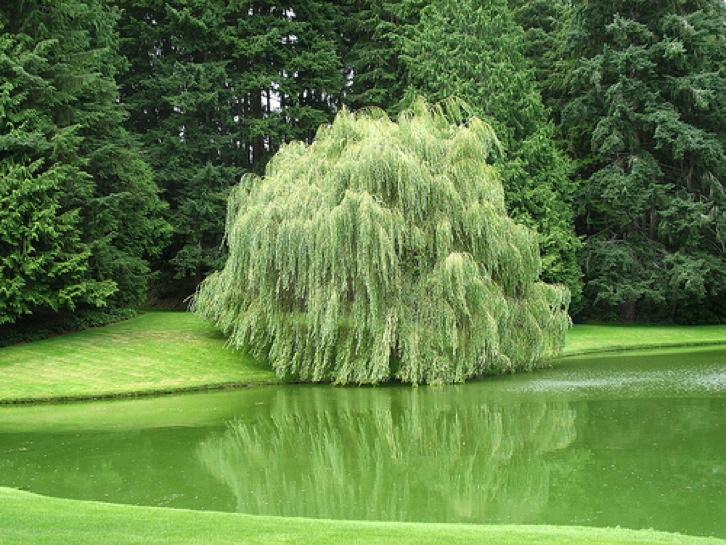

Weeping bush willow on the shore of a reservoir
Weeping cypress
The plant is originally from China, but feels great in Central Russia. Its height can reach 20-40 m over the years, depending on the variety. Cascading thin shoots are covered with scaly leaves. Like other conifers, it perfectly heals the air, is undemanding to the soil and gas pollution of the atmosphere.
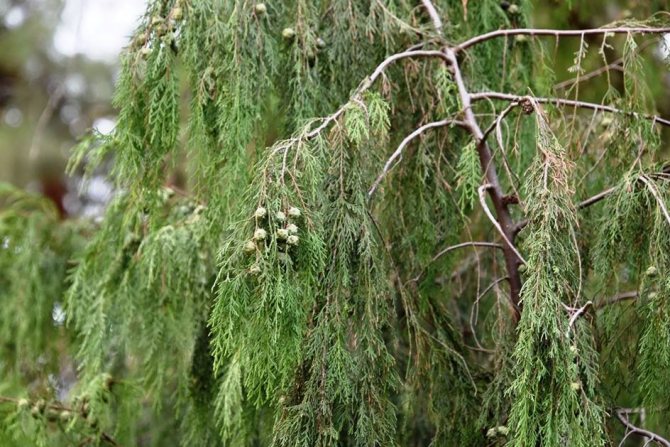

Weeping cypress branches
Weeping shrubs
With the help of grafting in garden centers, very interesting forms of familiar plants are created. This is how weeping ash, rowan and birch trees were obtained. Their buds are grafted so that the shoots growing out of them grow in a downward direction, not upward (as laid down by nature). Outwardly, such shrubs are very reminiscent of a weeping willow and look very impressive in the garden.
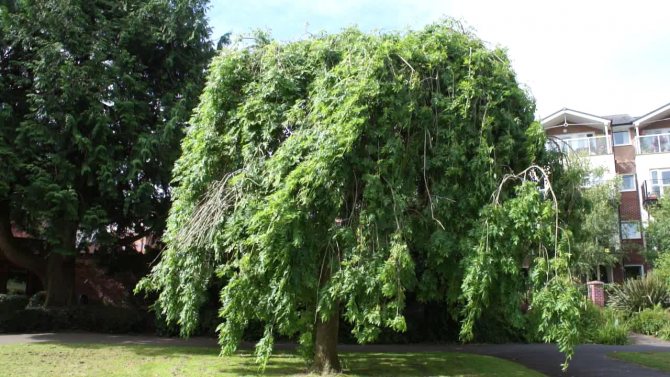

Weeping ash
Weeping rowan
The common mountain ash (Latin Sorbus aucuparia) is a vigorous fruit crop that can grow up to 12 m in height. Grayish-red naked shoots, together with ripe bunches of red berries, look very beautiful against the background of a winter snow-covered garden, giving it a traditional Russian flavor. If you give the crown an unusual shape using reverse grafting, you can get a very interesting result.
Important! A light-loving weeping tree looks best in spacious glades.
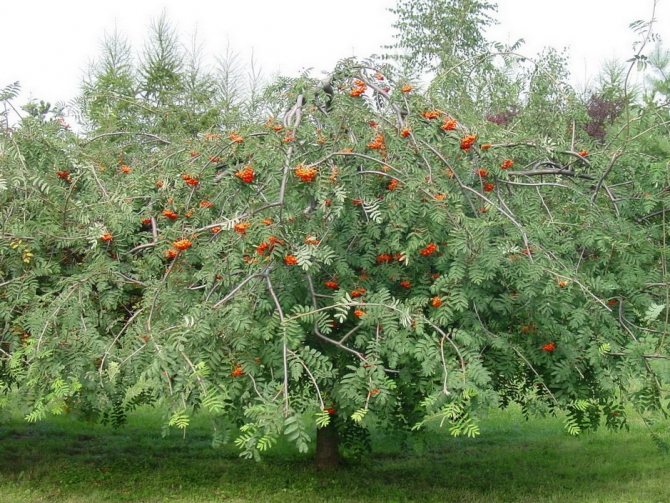

Weeping rowan
Weeping ash
Usually, under natural conditions, ash trees grow up to 35 m. Their even, but not too thick trunks are harmoniously combined with a light wide-round transparent crown. Usually, the shoots of an ash tree are arched upward. With the help of grafting, they are directed downward, obtaining a very decorative result, but significantly shorter.
The weeping ash tree is a real living tent, under the canopy of which children love to play. In summer, it gives excellent shade. At first, after grafting, the branches grow horizontally, but later they still curl downward in arcs. Outwardly, a weeping ash tree that has flown around for the winter resembles an umbrella. It can be planted in open areas and in partial shade.
Note! Ash is undemanding to the composition of the soil, but it prefers stable moisture.
Weeping birch
The deciduous tree is very common in the temperate climatic zone. Almost all species are tall, reaching a height of 30-45 m, and a trunk girth up to 150 cm.In group plantings, it looks beautiful due to a lacy green crown and a whitish (silver or white) shade of the bark. The root system is powerful, providing the tree with moisture in the most severe drought.
A weeping crown is given to birches in the usual way - by reverse grafting. Such trees look very advantageous next to gazebos, reservoirs.It is best to plant in a well-lit area to avoid stretching the crown and ugly deformation. The culture is very unpretentious to the composition of the soil.
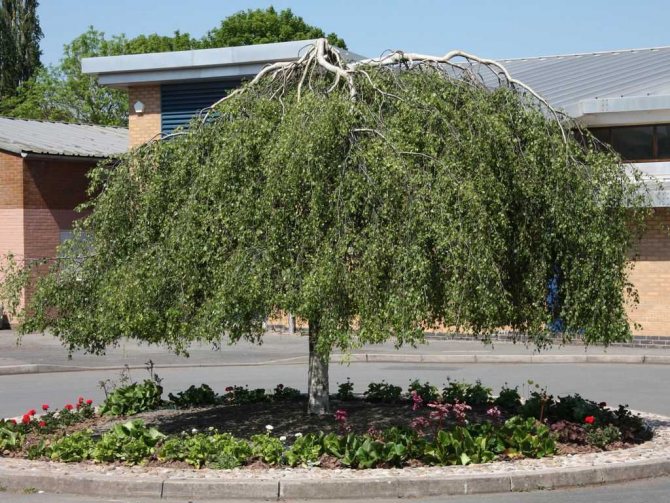

Weeping birch
Method one: pruning
This method provides for the gradual formation of a standard tree by cutting off lateral shoots and branches. While this process can be time-consuming, the end result will be amazing and beyond your expectations.
The first thing that needs to be done is to monitor the growth of side shoots, removing them in a timely manner. As soon as the planted tree reaches the required height (usually about one and a half to two meters), its top should be cut off. From this moment on, the crown will need to be pinned with the help of young shoots.
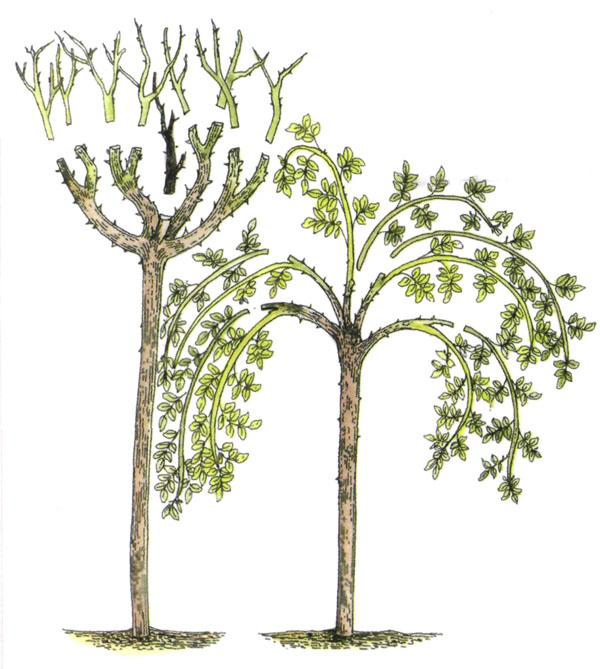

This procedure is laborious and painstaking, since it is recommended to wait one month between each pinching. In addition, new shoots will need to be added to the already split shoots.
However, you should not be afraid of difficulties. The result is worth it.
How can you grow a standard tree with your own hands using grafting? This will be discussed below.
The easiest way to get a beautiful front lawn
You, of course, have seen the perfect lawn in the movies, in the alley, and possibly on the neighbor's lawn. Those who have at least once tried to grow a green area on their site will no doubt say that this is a huge work. The lawn requires careful planting, care, fertilization, watering. However, only inexperienced gardeners think so, professionals have long known about an innovative tool - liquid lawn AquaGrazz
.
Consider several common plant species, the shape of which is a stem.
Stamp roses
Roses today have become quite widespread in garden decoration. In the garden decor, both standard flower-bed shrubs and ground cover roses can be used, which need support. Climbing rose varieties from a kind of cascading category are an excellent solution for creating a trunk shape. And roses in landscape design will complement any park plants. This kind of rose, like Austin, is quite often found in garden compositions.
Austin is a new variety of rose. She became in demand in England around the 80s of the XX century. Features of the Austin rose are reliability, growth stability, long flowering and versatility of use in park and other compositions. Austin needs maximum care, while it can easily fit into garden compositions.
Based on what kind of roses were used to create a composition in landscape design, you can get both the most accurate and at the same time quite low, and large varieties that rise above the lawns to a height of about two meters. Climbing varieties will serve to create large stem crops, comparable in size to small deciduous trees. At the same time, roses in landscape design are original and fashionable.
An important rule: it is not so difficult to keep track of the standard varieties of roses in landscape design, and cascading roses have a clear advantage here too - pruning these varieties every year, instead of almost full-fledged creation with difficult care, is replaced by selective pruning of the shoot.
Stamp rhododendrons
One of the most striking garden decorations are captive rhododendrons, they creep into the imagination with their distinctive features - impeccable bright colors, and these qualities reach perfection in boles. Vivid variety of color palette, flawless bloom, leaves hidden in May.
If many varieties of roses in the form of a stem look like air clouds in the video below, then they are formed in the form of hanging clouds on a deciduous substrate - huge, luxurious and graceful. With their unusual branching, they do not look like a perfect ball, however, the magnificent flowering compensates for this perfectly.These climbing rhododendrons must be protected at all times from both the bright rays of the sun and heavy rainfall, shaking off the water from the branches.
Stam bush
Consider an important nuance - the best varieties for planting a trunk are Yasiman rhododendrons and any varieties obtained on the basis of crossing, which are currently created on their basis.
Hawthorn and witch hazel are also used to form the stem. These plants are unpretentious, but no less colorful, especially during flowering. In the photo you can see a blooming hawthorn.
Getting a trunk using a mold
For a person who is far from gardening work, it is easiest to start creating boles by forming a trunk and at the same time not trimming the crown. This method requires a lot of work, but the result will be much better than your expectations. The process of creating a trunk can take a long period.
An important point: to create a plant in the form of a trunk, it is important to choose the right young seedling. Planting material should be purchased as even as possible, without any knots.
Standard rose
Let's consider how to get a stem:
- After planting the plant, the trunk must be tied to vertically located supports - a peg made of wood or metal driven into the soil.
- Then, as you grow, you need to tie the grown top to a special support, and it is better to cut off all the shoots on the sides.
- This procedure must be repeated as many times until the park plant is the height you want.
- Only at this time should you pinch the shoot at the top so that the crown has already begun to grow.
- Pretty quickly, young shoots will begin to grow near the place of pinching, which, as they grow, will also need to be pinched. Then you will get a fluffy and at the same time quite dense crown.
Care of standard plants
Oddly enough, garden shrubs in the form of a trunk require specific care. Due to the fact that the central part of the stem of this variety is bare, and the crown is located at a great distance from the soil surface, almost all crops that were created in such an unusual way are quite sensitive to cold air currents and temperature changes.
23 September 2020, 06:45
Recently, standard plants are becoming more and more fashionable. Their main feature is a long, even trunk without a single branch, which ends with a lush crown. In this way, you can not only create the original shape of the trees, but also raise the shrubs, giving them an unusual appearance. And the tree on the trunk will fit well into all strict or, conversely, ultra-modern forms of landscape design.
Method two: vaccination
The grafting (or transplantation) method is much more complicated than the pruning method, but the results of the manipulations will be visible within a few months. What is needed for this?
First of all, you need to take two seedlings, one of which will play the role of a rootstock (or trunk), and the second - the role of a scion (from which the crown will form).
Grafts are best harvested in the fall. To do this, young shoots (one centimeter thick and up to half a meter long) are cut from the fruit tree, packed in plastic wrap, wrapped with coniferous branches and buried. Such actions will help the cuttings retain the necessary energy for engraftment in a new place and subsequent development.
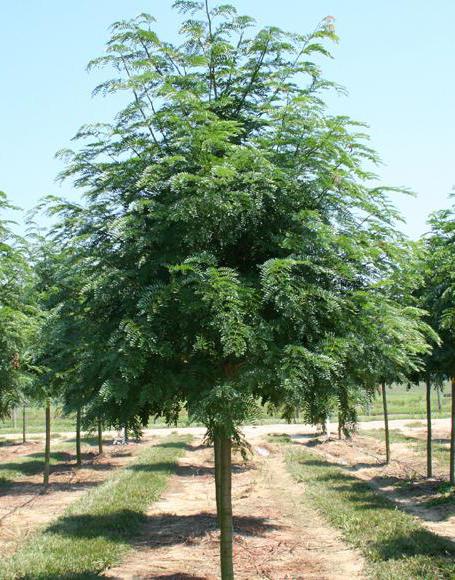

It is best to plant two of the same crops. Sometimes related plants are used for this (for example, pear and mountain ash), thanks to which the trees begin to bear fruit faster.
Planting and caring for coniferous boles
Having considered the varieties of standard plants, we will get acquainted with the method of planting coniferous boles. When buying a plant in a nursery, a prerequisite is to remember the location of the cardinal points. It is worth tying a ribbon on a branch on the south side of the tree in order to maintain this position when planting in the ground on your site.By observing this condition, it is possible to accelerate the adaptation of the plant to a new place.
The planting depth should correspond to the height of the formed root system with a margin of 15-20 cm. The stock is made to create a bottom cushion consisting of mixed coniferous sawdust and river sand in a ratio of 2: 1. This pillow can also be added to the lateral edges of the roots. Black earth is sprinkled on top for compaction and nutrition. Careful attention to watering (as it dries, the soil must be moistened, but not poured) will help any coniferous trunk quickly take root. Do not forget to cover the crown of the ephedra for the winter, so as not to irradiate the delicate needles and cut edges of the branches with the sun.
Highlights of grafting
What rules must be followed in order to grow a beautiful standard tree, pleasing to the eye and harmoniously fitting into the design? Here's a quick step-by-step guide:
- Grow the base (or stem). A young seedling is tied to a support and allowed to develop to a certain height.
- Take a healthy stalk with two to four living buds.
- Above the upper bud of the cutting (scion), make an oblique cut, and in the lower part, using two slices, create a semblance of a wedge.
- With a pointed section (wedge), carefully insert the scion into the stem so as not to damage the latter.
- Treat the junction with a garden pitch and tie it with a plastic band or electrical tape, which over time can be changed to new ones, and after a year it can be completely removed.
- After a month, the stalk should take root, and new buds will appear on it. Freshly baked shoots will soon form, and as soon as they grow twenty centimeters, they will need to be pinched correctly.
Vaccinations should be manipulated in the spring, in dry, sunny weather, so as not to bring bacteria, fungi or infection into the junction.
A haircut
Thuja perfectly tolerates a haircut. This stimulates the growth of young shoots, and as a result, the crown becomes thicker and fluffier.
- regular correction of the compact shape of the crown;
- removal of root shoots and standard shoots;
- sanitary pruning of dry, damaged branches as needed.
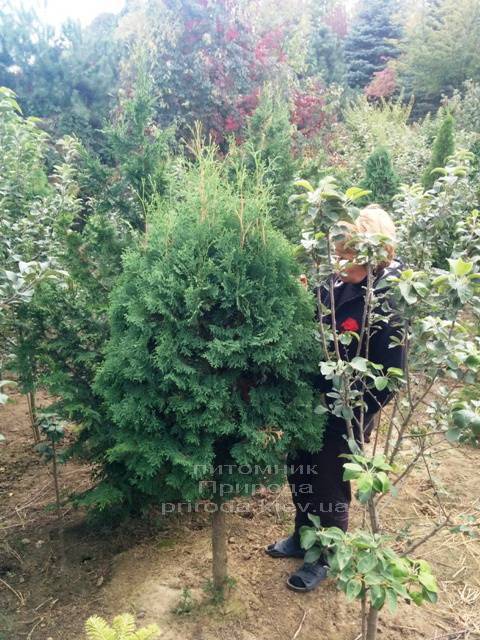

Thuja on a trunk PHOTO Plant nursery Nature Priroda
Growing standard bushes
The formation of a stem from bush plants is very popular. This facilitates the maintenance of the horticultural crop and also contributes to the convenient harvesting.
To form a standard shrub, like a tree, there are two ways - by grafting or pruning. However, it should be remembered that such extraordinary bushes need constant support, since even ordinary gusts of wind can break thin long branches. Therefore, it is recommended to tie each shoot to a wooden or metal peg.
What horticultural crops can be used to form standard shrubs? First of all, these are raspberries, currants, gooseberries, irga and others.
Let's talk briefly about standard raspberries.
Raspberry bush in the form of a trunk
The standard raspberry tree, unlike its other relatives, does not need support. Under the weight of the sweet harvest, its branches can bend, but not break. Such a plant can reach two meters in height, but still it cannot be called a full-fledged tree. Standard raspberry is an artificially grown shrub in the shape of a tree.
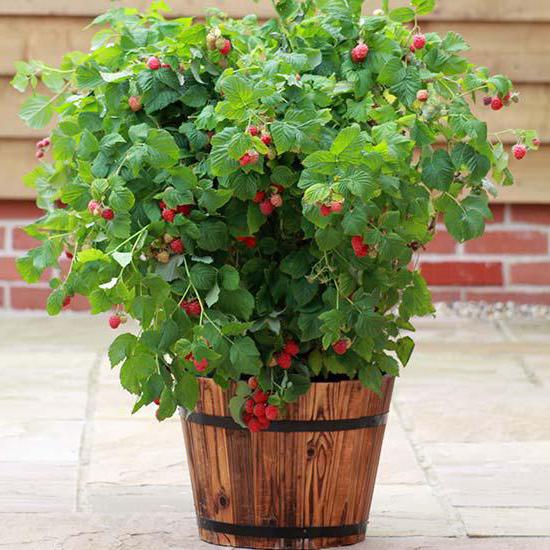

How can this be done?
At the initial stage, all fruiting branches should be removed, and the upper part of the young shoot should be pinned.
If you do not want to mess around with the formation of a raspberry bush, then you can purchase an already grafted standard tree, but this must be done not in the market, but in nurseries, gardening stores or from your hands - when you see mother bushes from which a cutting will be cut for you.
How to care for standard raspberries?
Planting a "raspberry tree"
First of all, the raspberries should be planted correctly. For this, a well-fertilized soil is used. The place is chosen damp, slightly shaded, without drafts and groundwater.
Shrubs are planted close to each other, preferably a meter from the fence, on its southern side.
It is not recommended to place this berry plant among fruitful trees or next to garden crops such as tomatoes and potatoes.
The method of planting standard raspberries is very unusual. Here is an indicative principle of operation:
- Dig a deep trench, at the bottom of which to place humus, peat, compost, ash and other mineral supplements.
- Cover fertilizers with earth.
- Prepare a pit for each shoot: at a distance of one meter, form cells with a diameter of 40 by 15 cm and lay them out with slate.
- Cut raspberry seedlings to a height of forty centimeters and plant in cells. The root system should be deepened by four centimeters.
- Every two to three days, the shrubs must be watered with water using liquid fertilizers.
Standard raspberry is an unusually tasty berry of large size. With proper, good care, its yield per season can reach two kilograms per bush.
Benefits of standard trees
As you can see, the standard tree is not just a decorative element of landscape gardening design. This is a very easy-to-grow and care-for culture that you can form with your own hands, without using expensive or hard-to-find means and methods.
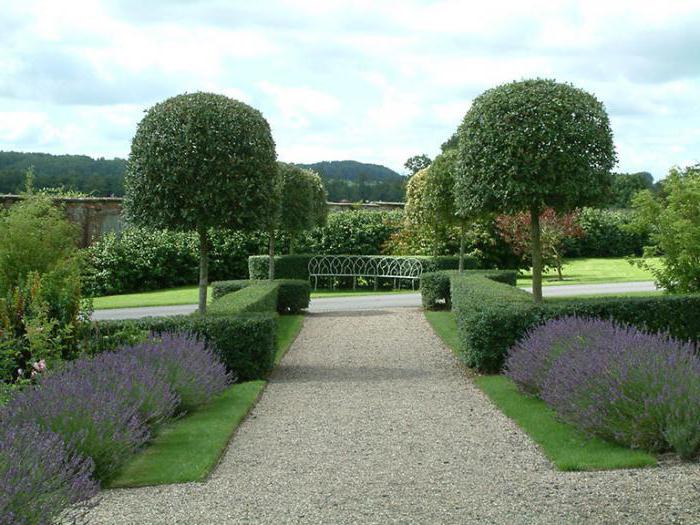

It is worth making only a little effort and skill, and then your standard tree will certainly delight you with a spectacular appearance, unusual design and large tasty fruits.
Recently, plants in the form of a trunk are gaining more and more popularity in landscape design. They look very impressive and original. But not everyone knows what a stem is. A plant on a trunk is a plant that has an even trunk, without unnecessary branches, looking like a stick stuck into the soil, and above the foliage going down or a fluffy crown in the form of a ball.
The flowering species of standard trees and shrubs look very beautiful. This shape can be achieved using two methods: grafting on an even trunk, on which there are no lateral shoots, and using a special haircut.
The multicolor of the coniferous trunk
Conifers are also involved in the trunk, such as:
Considering the vastness of Russia, we can safely talk about an easy way to stamp conifers. The possibility of creating an extraordinary appearance of your site is achieved by growing evergreen trees in the form of a trunk.
Everyone's favorite tree with spiny needles close to each other creates fluffy branches. The tree reaches amazing beauty in the spring, during the period of regrowth of young pale green shoots. The existing varieties of prickly spruce, oriental spruce and Canadian spruce (gray) are considered dwarf with slow growth. This quality is the first plus, the second is good cold resistance, and the third is easy processing and cutting. On New Year's holidays, such trees are decorated with garlands, which creates a fabulous atmosphere around the house.
What are the standard plants?
Standard plants can be of different heights, although they usually range from one and a half to two and a half meters. However, sometimes there are specimens that can reach a height of up to five meters. Such types of plants attractive at any time of the year - from the earliest spring to late autumn. In the summer season, trees and shrubs bloom magnificent flowers and fruits.
In addition to their special beauty, these trees have their own advantages:
- they can help save space due to a compact crown;
- trunk circles are easier to handle;
- it is easier to harvest from standard bushes with berries.
Some of the most common forms of standard trees are weeping... These include weeping mountain ash, goat willow, apple varieties that have hanging shoots, elm and many others.
Plants with such shoots were found in the wild or artificially bred. When the plants are grafted into the lower part of the rootstock, the seedlings are obtained with creeping branches. And if the grafting is carried out on a high trunk, then a penetrating crown is formed at the tree. It is customary to distinguish four types of penetrating branches:
- reflex - there is a growth of shoots vertically down, which is similar to weeping elm;
- inverse - the growth of shoots down the arc is noted;
- pendula or weeping form, that is, when the branches hang down at an angle of thirty or sixty degrees;
- Umbrella - with a similar shape, the tree has curved shoots, some of which can be directed horizontally, and some slightly up. An example is an umbrella-shaped apple tree.
Daurian Juniper (Juniperus davurica)
It grows naturally in the Far East, in Eastern Siberia, in the north of Mongolia and China. Slow-growing creeping shrub with ascending branches, up to 0.5-1 m high. Needles are needle-like, scaly at the ends of the shoots, bright green in summer, turns brown by winter.
Round cones with a diameter of 5-6 mm, dark blue with a bluish bloom. Winter hardiness is high. Rare in culture.
Juniper Daurian Leningrad
The most famous variety of Daurian juniper. The needles are green, olive-brown in winter.
How to make a stem by molding a plant
The easiest way to make a stem is to form required type of crown. It is available even to inexperienced gardeners who have decided to have a standard tree. According to this method, it is necessary to cut the lateral shoots of the trunk and this may take a longer period of time. However, the result will be remarkable and will exceed all expectations.
To make such a tree with your own hands, you should adhere to a few simple rules:
- the seedling for planting must be chosen correctly and it must have a smooth, even trunk;
- after planting the plant, it is necessary to tie it to a metal peg;
- in addition to growth, the top of the tree is tied further to the support until the required height is reached;
- as soon as the required height is reached, the top must be pinned.
After performing these simple manipulations and pinching the top of the tree, side shoots will begin to grow. They usually do not keep themselves waiting long. Young shoots also need to begin to pinch. Thus, a fluffy crown will begin to form near the tree.
Getting a trunk using shaping
The easiest way, if you are a person far from gardening delights, is to try to create a stem by shaping the trunk and trimming the crown. This method will require a significant amount of time, but the result will meet the wildest expectations.
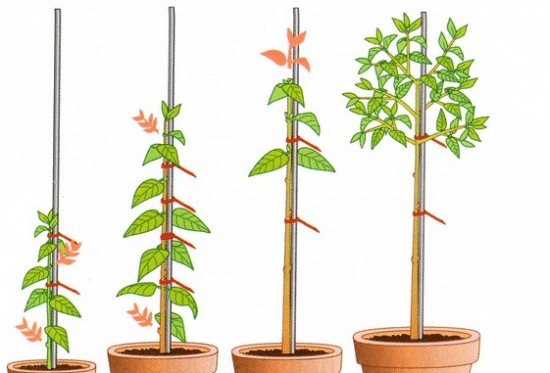

The process of forming the trunk can take a long time.
To bring this idea to life, it is important to choose the right young seedling. The planting material should be as even as possible, without knots. Immediately after landing, its trunk is tied to a vertical support - a wooden or metal peg driven into the ground.
Further, as it grows, it is necessary to tie the growing top to the support, and mercilessly remove all lateral shoots. This procedure continues until the stem reaches the desired height. Only then can you pinch the apical shoot so that the crown begins to grow. Very quickly, young shoots will begin to appear near the pinching site, which, as they grow, also need to be pinched. Then the crown will turn out to be thick and fluffy.
Stamp plant by grafting
Graft - this is another way to end up with a beautiful standard tree. However, this method will be a little more complicated than the first one. This procedure will require two seedlings. The first is a rootstock, which will act as a stem, and the second is a scion - from which the crown will eventually form.
In order for the stem to turn out to be successful, you must first decide on the seedling that will serve as the stock. Most often used the same by plant culture, but the stock must be genetically stronger. For example, a rose can be grafted onto a rose hip, a weeping elm variety on a rough one, etc.
One of the easiest grafting methods is to plant two of the same crop. However, there is also a more complex one - when related plants are grafted, but at the same time their different types. For example, the stem is made mountain ash, and pears are grafted and the like. It should be noted that such pears begin to bear fruit several years earlier, that is, already 2-3 years after planting.
To obtain a standard tree, several rules must also be followed. As a result, you will get a wonderful tree and will definitely decorate the landscape design:
- First of all, you need to grow a stem. This is done in the same way as when forming the crown, that is, the seedling is tied up and grown to a certain height.
- Then it's time to graft the plant. To do this, take a stalk that is suitable for the culture. It needs three or four living kidneys on it. Better to do this in April.
- On the scion at this time, an oblique cut is made over the upper bud. And in the lower part of the scion, you need to form a wedge using two slices.
- The wedge, which turned out as a result, must be inserted into the stem. This must be done very carefully so that the stem itself is not damaged. The place where both plants are connected must be tied up with plastic tape; in order to avoid decay, the plant of the cut site is treated with garden pitch.
- After about a month, the stalk should take root and the first buds should awaken on it. In the future, young shoots will begin to develop from them. These shoots need more careful care, because they need to be pinched on time. The tree on the trunk by the end of the second season will look fully formed and beautiful. And making a standard tree with your own hands is not difficult at all, as it might seem at first glance. And landscape design will only benefit from this.
Weeping deciduous deciduous woody with artificial crown
The selection of human-made pendula forms is much richer. Often, a single branch, clearly bent down, found in nature, in a nursery, becomes the progenitor of a new weeping form.
Weeping decorative peach, photo by the author
Pendula forms often grafted onto the stem become compact and more expressive.
Weeping apple tree, appearance and flowering shoots, photo by the author
With seeds taken from these forms, it is impossible to get a weeping tree in the future. They are created in nurseries by grafting on a stem with a handle, a kidney (eye). The inoculation site is clearly visible at first (it is usually covered with paraffin).
In the presence of a rootstock-stem and scion-twigs (of the same type), summer residents can make the pendula shape themselves. At first, the tree will be low (the height of the rootstock trunk on which the graft was made), but over time, the stem will grow slightly upward, and the weeping crown will become wider.
Goat willow 'Kilmarnock'
A miniature tree on a trunk with hanging yellow-brown shoots.
Goat willow 'Kilmarnock', appearance. She's in bloom. Photo from limecross.co.uk
Goat willow 'Kilmarnock' (Salix caprea 'Kilmarnock') 1.5-2 m high and up to 2 m wide; especially decorative in April-May, covered with golden earrings.
Purple willow 'Pendula'
A graceful willow tree with flowing branches.
Purple weeping willow, appearance. Close-up of her shoots.
Weeping willow (Salix purpurea 'Pendula') enchants with long thin branches with light green (bluish below) leaves.
Willow 'Erythroflexuosa'
A decorative form with a complex name is often marketed as the Matsudana willow.
Willow 'Erythroflexuosa'. Photo of the site.
Willow (S. ‘Erythroflexuosa’, syn. S. ‘Golden Curls’, S. matsudana ‘Tortuosa Aureopendula’) - a sprawling tree 5 m high and wide, with arched shoots (young ones are orange-yellow).
Formation of a trunk on shrubs
Not only trees are formed into trunks.The increasing prevalence is gaining standard bushessuch as currants, gooseberries, irga and other fruiting garden plants. And this popularity is understandable. Such plants are easier to care for, harvest, etc.
Standard currants, gooseberries and other shrubs, like other trees, are obtained in two ways: removing side shoots and forming a crown or by grafting.
You can easily transform an ordinary currant bush or other garden berry bush with the help of grafting. This is done in early spring, when active sap flow begins. Well suited as a stock for currants golden currant.
It can also work for gooseberries. Everything else happens in the same way as grafting on trees. The junction of the plant is wrapped in foil. After a while, buds will begin to appear on the scion and shoot growth will begin. At this time, the film is no longer needed. After removing the film, the resulting bush should be secured.
I must say that neither currants nor gooseberries in the form of a standard tree can grow without supports... Strong gusts of wind can easily break new unusual bushes. The support can be wooden pegs or metal rods. Unfortunately, such intervention is indispensable when growing standard currants. In the next season, the tree will give the first fruits from the standard shrub, which usually have slight taste differences and a larger shape, to taste.
Topiary: important nuances
For basic work, it is best to use power-driven garden shears... They are designed for pruning dry and thick branches. For finishing touches, when it remains only to correct some details, or for young thujas with delicate shoots, use straight shears without drive.
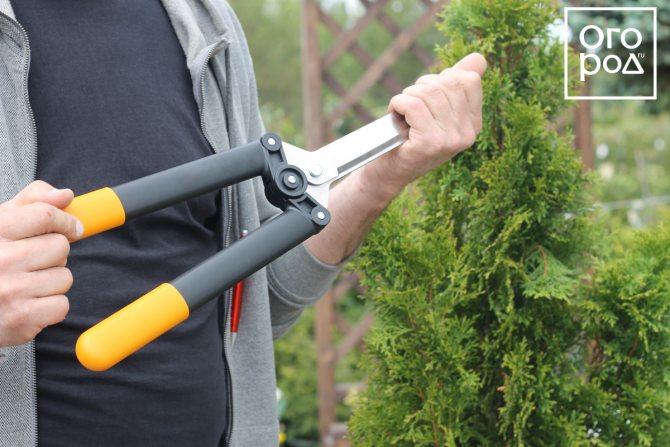

The shape of the topiary must be constantly maintained. We do not recommend starting a curly haircut if you plan to trim it once and forget about it until the end of the season. In fact, without constant adjustment, the shrub will return to its original shape by the end of summer - there will be no trace of topiary pruning.
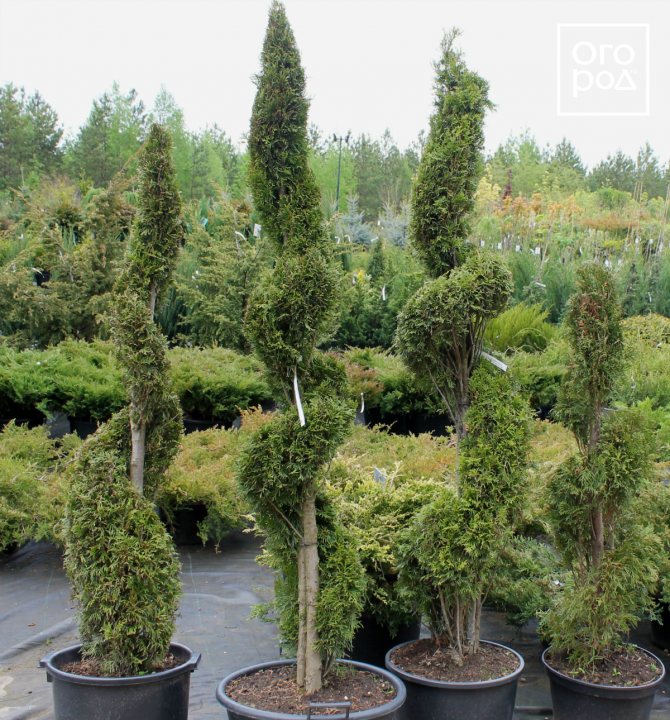

Tui haircut time - from late May to late September... If you do topiary pruning of conifers later, they will not have time to restore and increase the amount of green mass sufficient for normal wintering.
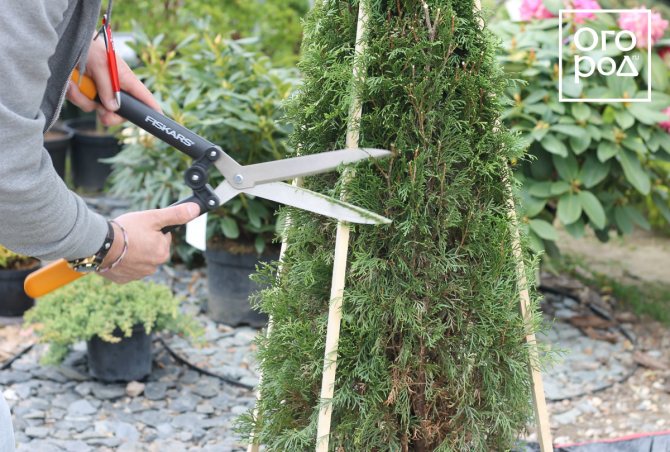

Lush mature trees are used for topiary. A "liquid" bush will not make a good figure.
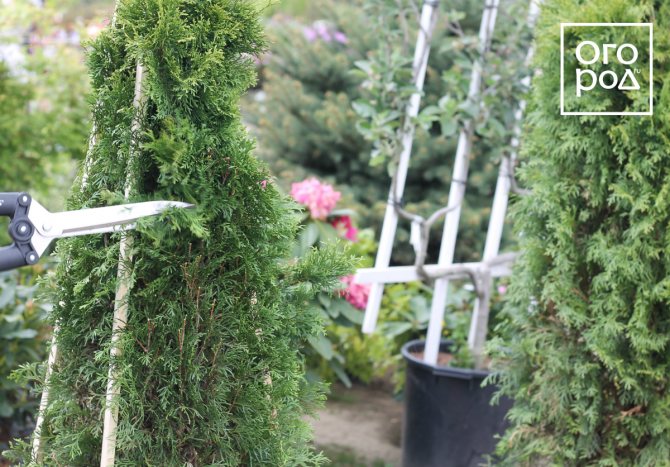

Do not cut too short. Otherwise, you will expose the bush.
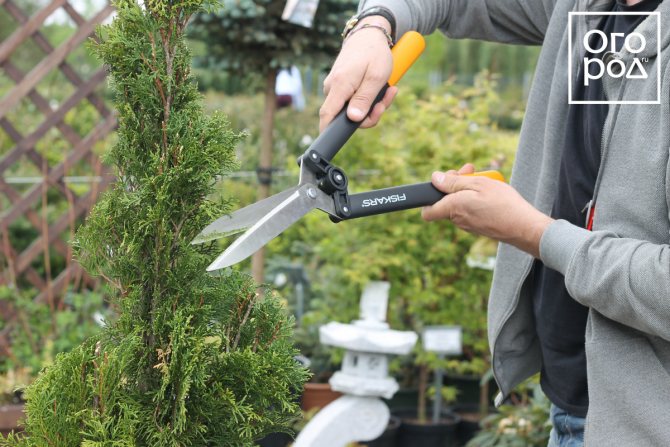

Prune the tree each year to a slightly larger size than last season (adding about 5 cm in volume from the previous pruning). If you constantly cut the thuja to the same "dimensions", after a few years the shrub will thicken strongly on the inside. Let the thuja "plump"!
Brown twigs must be removed. Unfortunately, there is no way to "revive" them. If a significant part of the shoots has turned brown, cut them off gradually, and not in one fell swoop.
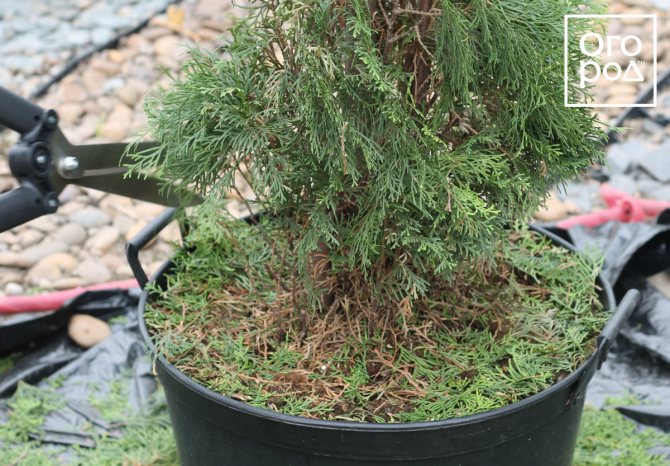

Do not expect to turn an adult thuja into a complex topiary shape. (for example, the figure of an animal). Shrubs in the form of bears, bunnies, etc. are formed on a special frame from the first years of life, and the haircut in this case only maintains a given shape.
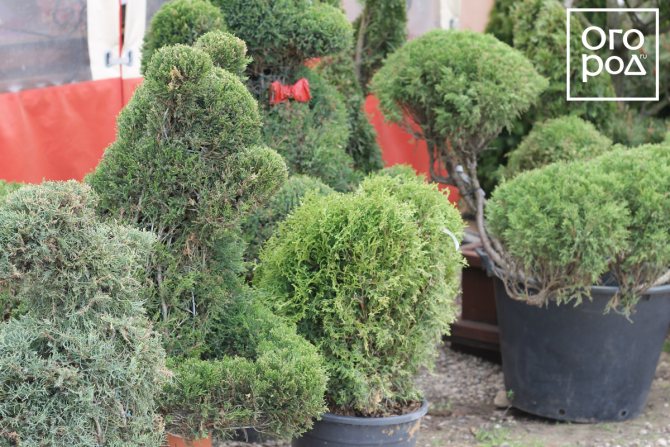

It is almost impossible to turn a hedge into a topiary! Planning whether you want to turn the thuja into a topiary or use it as a hedge is necessary already at planting.
Well, now let's get down to scissors!
Types of standard plants
Let's start with the definitions. What is a stem? In botany, a trunk is called a tree trunk from the neck to the skeletal branches. Usually, in trees, this distance is not very long, therefore, plants on the trunk are usually called such trees and shrubs, whose trunk is artificially lengthened.
Both deciduous and coniferous plants can be grafted onto the stem. Creeping juniper varieties grafted onto a high trunk look very unusual.
By the shape of the crown, standard plants can be divided into the following categories:
- spherical - the crown consists of solid branches, which are pruned in such a way as to obtain the shape of a ball;
- weeping - soft branches descend almost to the ground.
Grafted shrubs, for example, a rose, look great as weeping ones. If desired, the crown can be shaped into other geometric shapes.
Using
Standard thuja hardy, resistant to urban conditions. It will significantly decorate the surrounding space, it will look laconic and colorful in any landscape. Retains a high decorative effect throughout the year. It is applied for:
- alleys, small or topiary gardens;
- various landscape compositions;
- container gardening of terraces, balconies, patios;
- decoration of the facade of the house.
Due to the content of essential oils, it is used in medicine and perfumery. Back in the 19th century, an extract of ephedra in the form of a tincture or ointment was used to treat warts, ringworm, etc. It has diuretic, astringent, expectorant properties.
Thuja, like all conifers, is a source of clean air.
You can buy Tuyu on a trunk with a trunk circumference of 10 - 14 cm in Kiev at the Nature Plant nursery (Priroda)
Sale of thuja produced in our nursery or in the online store.
Thuja price depends on the variety, the size of the plant and the splendor of the crown.
We provide services for planting tui and other plants. We grow seedlings and large-sized thuja in pots and with a clod of earth.
How to make a plant on a trunk
Usually nurseries are engaged in the cultivation of standard trees and shrubs. However, if you have the time and desire, you can try to do it yourself. There are two ways to create plants on a trunk.
Pruning
If you are thinking of making a standard plant by pruning, choose the smoothest and strongest seedling. To prevent the wind from breaking it, tie it to a peg driven into the ground. In the process of growth, the peg will have to be replaced with a longer one so that it always remains the same height as the stem.
Pruning for a stem begins as early as the first year of the seedling's life. All lateral shoots must be removed as soon as they have just begun to hatch. This continues for quite a long time - until you are satisfied with the length of the trunk. Once your tree has reached the desired height, you can pinch the top and wait for the shoots to form the crown.
The crown itself needs no less care - constant pruning and shaping should help keep the shape of a perfect ball. Otherwise, the tree will not look so impressive.
For this method, trees such as maple, mountain ash, pine and juniper are perfect.
Graft
The grafting method is a little more difficult, but works best for most trees and shrubs. Let's start with terminology again. The grafted standard tree can be conditionally divided into two parts - the stock and the scion. The stock is called the stem itself - a smooth trunk without branches. Usually, a plant is taken for the stock, which belongs to the same botanical genus, but is more robust, resistant to pests and diseases, and has a powerful root system. For a rose, for example, such a plant would be a rosehip, and for a cedar - a pine. But the scion is directly the crown itself, that is, the plant that we grow.
The first stage of growing a grafted bole tree is very similar to what we described in the pruning method. A tall and smooth stem is grown from a rootstock plant. As soon as it reaches the desired height, you need to cut off a few centimeters at the top of the trunk with a sharp knife, and then make a split - that is, make a vertical cut about 3-4 cm deep.
As a scion, we need a stalk with several buds. The lower part of the cutting must be made wedge-shaped with a knife, and then inserted into the cleft. If the trunk is thin, you should be especially careful.After that, the vaccination site is tightly tied with plastic tape. The top of the scion must be cut over the upper bud and the cut site must be treated with garden pitch.
After that, young shoots are pruned so as to give the crown the shape of a ball. Approximately two years after vaccination, you will have a beautiful standard tree.
Spiral
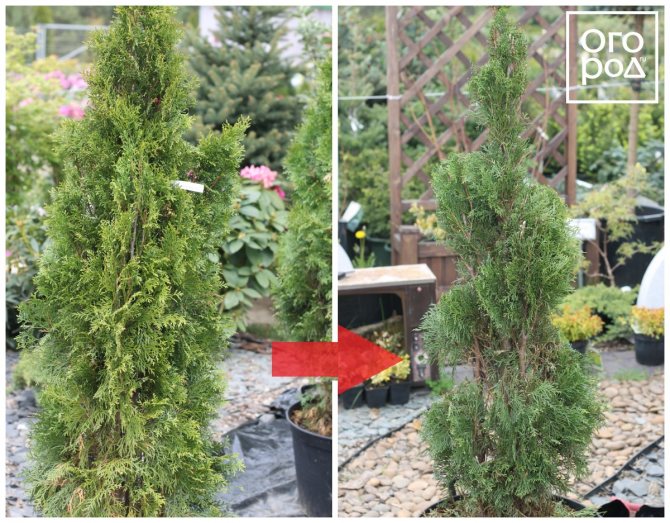

Perhaps this is the most common topiary form. We are sure that you have seen “curls” of conifers more than once in gardens and parks.
In order for the spiral to be beautiful and spectacular as a result of cutting the thuja, the plant must be formed on a trunk.
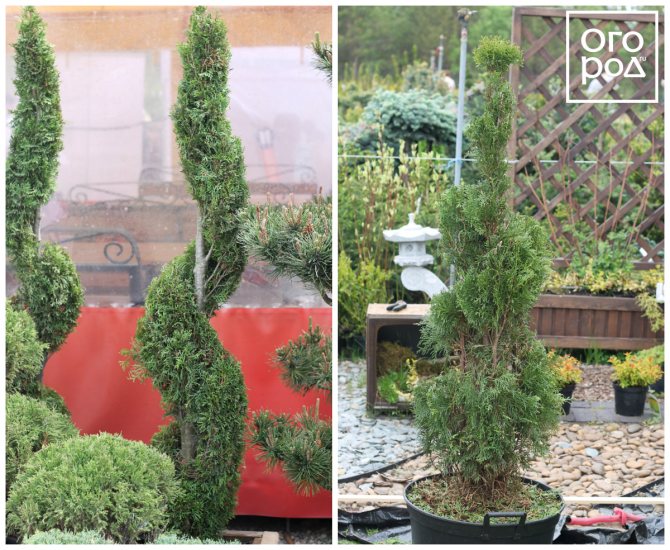

Spiral on a thuja with one (left) and several (right) trunks
If you have a shrub with several trunks at your disposal, you can also try to turn it into a spiral. True, for this you will have to tie the trunks so as not to let them disintegrate like a fan.
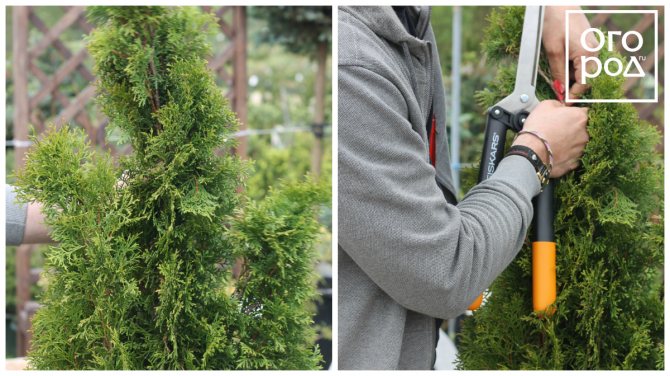

Trunks are best tied
The easiest way is to wrap it with a thick ribbon stencil, repeating the shape of the spiral. This will give you a good view of the hairline. Along this line and will need to "bite" into the bush.
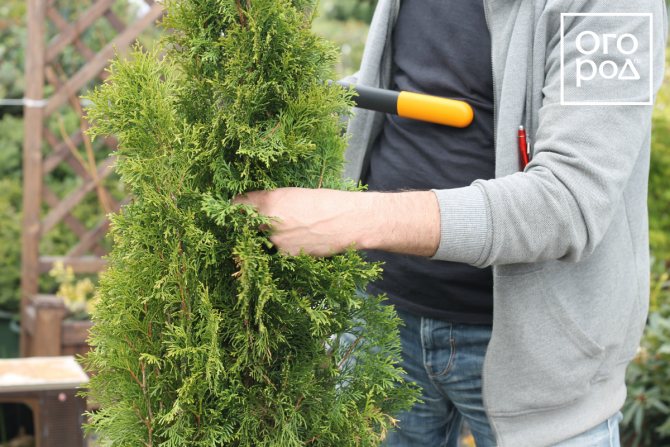

If you are good at defining the shape visually, you can cut it without a stencil.
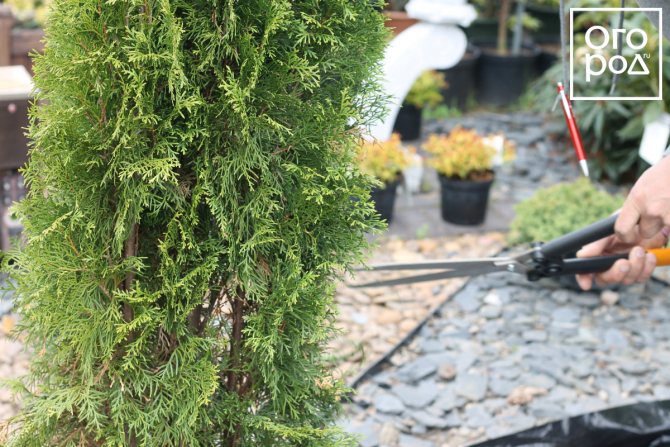

First, remove all the uneven and dry branches, and then start cutting the spiral along the marked line.
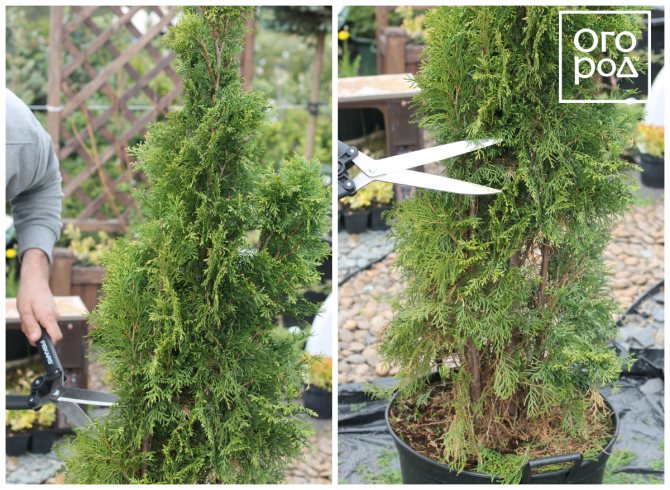

During the first circle, don't go too deep, just draw a spiral line for yourself.
Gradually trim the bush deeper and deeper until it gets the desired shape.
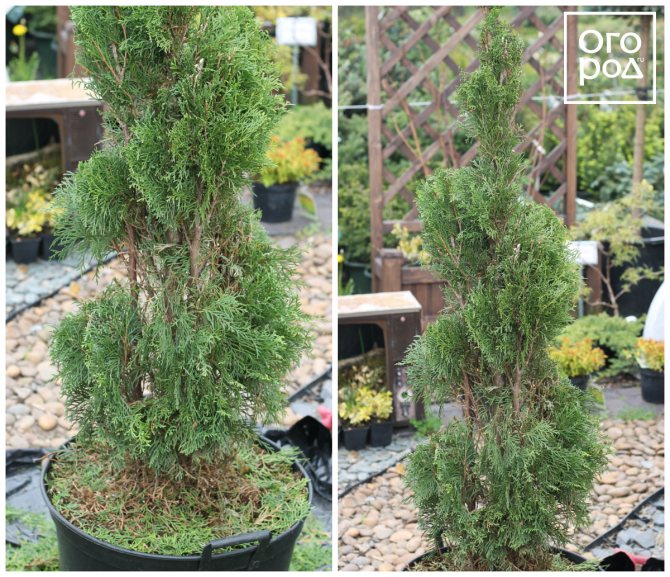

We hope our master class has inspired you to take up your garden shears and experiment with your thujas! By the same principle, you can cut other shrubs that are used to create topiary.
Standard plants in the garden have always attracted increased attention, as something extraordinary. It would seem that it is a completely standard rose or currant, but it grows completely differently than it should. And it's already difficult to call it a bush. Imagine: a dense crown-cap or a cascade of falling branches is located on a perfectly flat high trunk. The most interesting thing is that a similar effect was achieved not by breeding new varieties, but by proper formation or grafting. Usually, specialists are engaged in the cultivation of boles, and amateur gardeners acquire them already formed in nurseries. However, you can try and create a standard culture on your own - it's not too difficult if you know some of the nuances. We will talk about them now.
Standard plants in landscape design
The height of standard plants can be different - from 1 to 5 meters. However, the most popular are trees with a height of about 1.5 meters, as they fit perfectly into any design.
Lower plants work well on alpine slides or as hedges. Unusual alleys are made of tall standard plants
Trees and shrubs with bright and unusual flowering look especially good in the form of standard ones: rose, budley, cherry and apple tree. Coniferous plants look no worse - they form thick bluish-green balls that turn white when snow falls.
Care and cultivation
Thuja is an unpretentious, hardy coniferous plant. It is not demanding on soils, but prefers moist fertile soils, rich in organic matter. Grows well in open sunny areas and light partial shade. In full shade, the crown can lose density and become loose. It tolerates frost well. General tips for successful cultivation:
- planting strong healthy planting material with a well-developed root system;
- optimal irrigation regime, excluding stagnant waterlogging;
- timely fertilization and loosening of the root circle;


